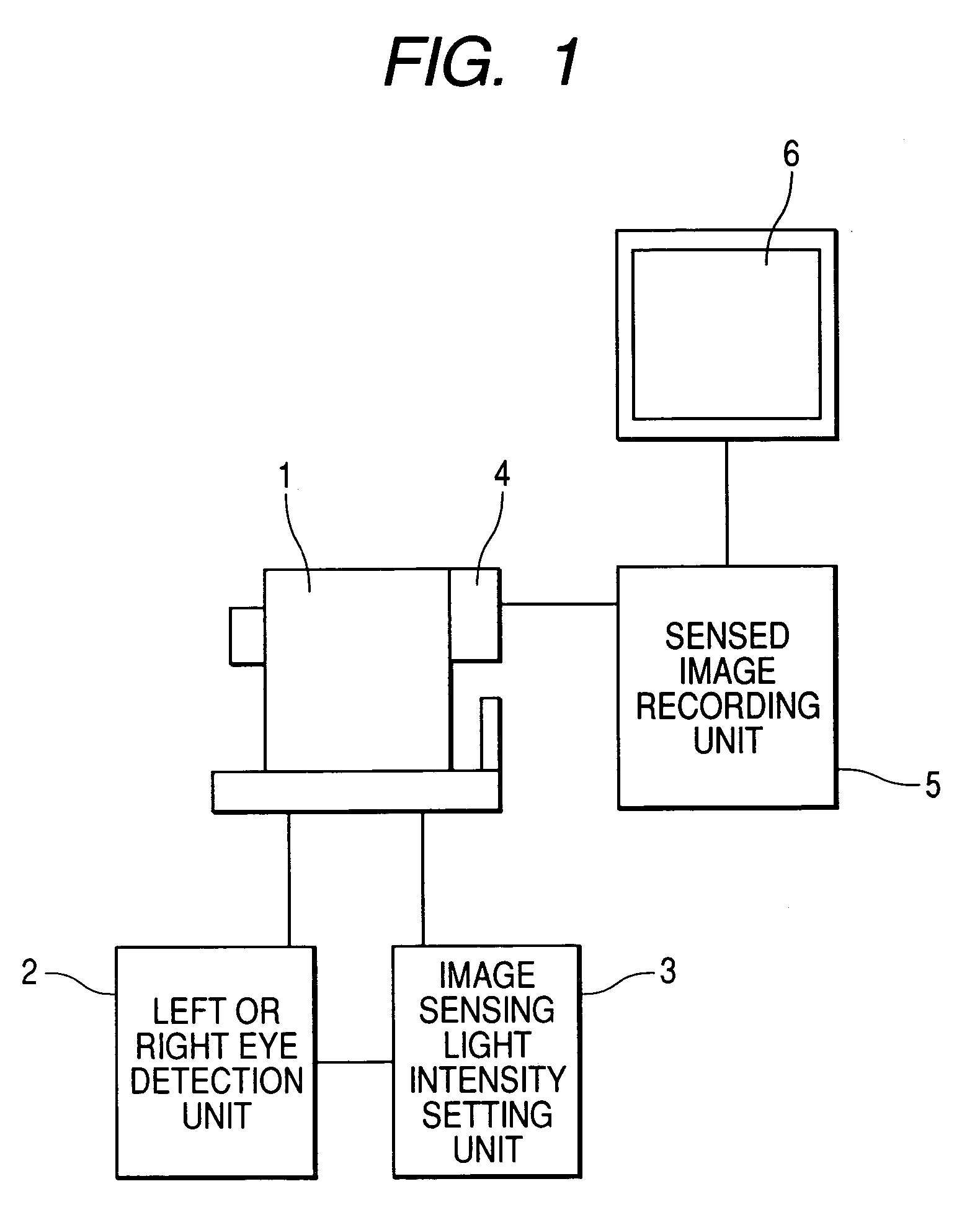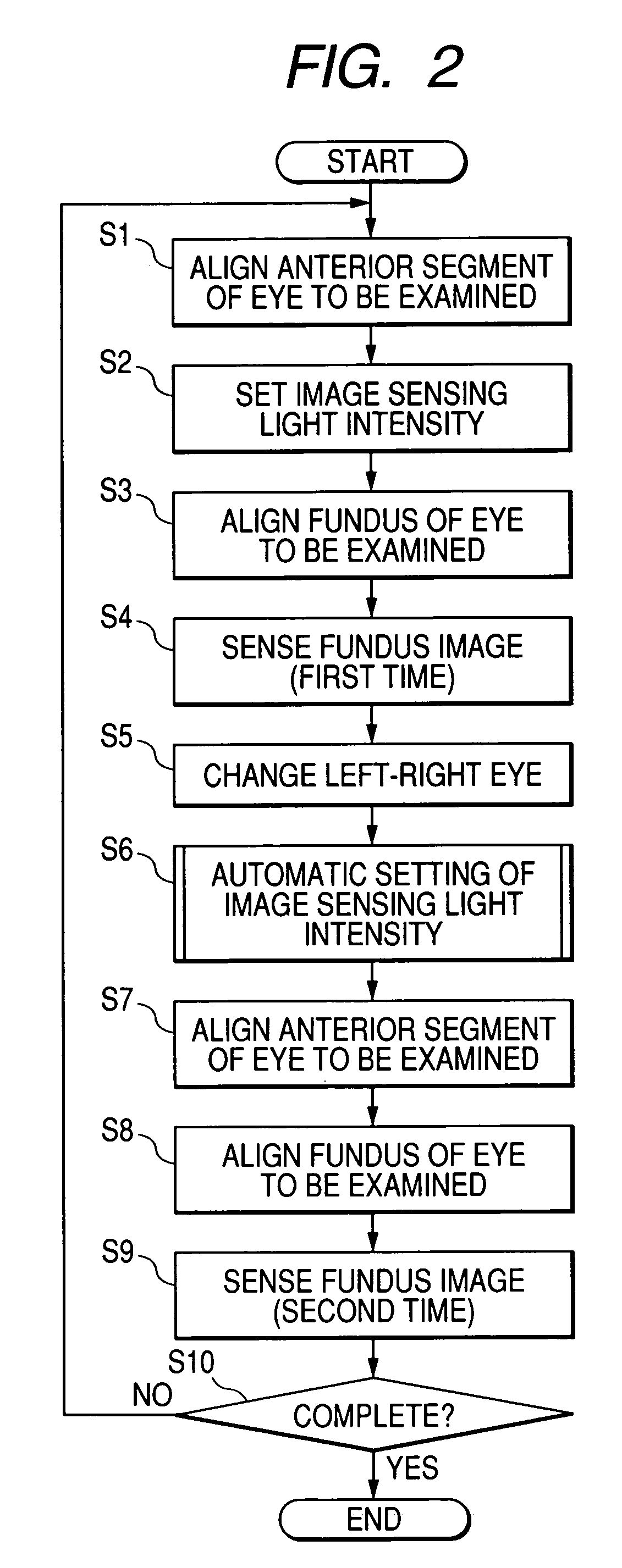Ophthalmic image sensing apparatus
a technology of image sensing apparatus and ophthalmology, which is applied in the field of ophthalmic image sensing apparatus, can solve the problems of forgetting to return the adjusted light intensity, difficult to set the proper image sensing light intensity from the state of the pupil, and the image of the eye to be examined which is image sensing later becomes dark. , to achieve the effect of reducing the adjustment burden of image sensing light intensity
- Summary
- Abstract
- Description
- Claims
- Application Information
AI Technical Summary
Benefits of technology
Problems solved by technology
Method used
Image
Examples
embodiment 1
[0047]FIG. 1 shows a structural diagram of an apparatus of a first embodiment. A left or right eye detection unit 2, an image sensing light intensity setting unit 3, and a CCD camera 4 sensing an image of a fundus of eye to be examined are added to a fundus camera 1. An output of the CCD camera 4 is connected to a sensed image recording unit 5, which records a sensed fundus image, and a monitor 6 which displays a sensed image.
[0048]FIG. 2 is a flowchart of an execution procedure of the first embodiment. In a case of right and left eye fundus image sensing in a mass health examination, the alignment of an anterior segment of eye to be examined is performed first (step S1). This alignment of an eye to be examined is performed by illuminating an anterior segment of eye to be examined by an observing light source for an anterior segment of eye at a near-infrared wavelength in the fundus camera 1, and moving an optical base unit in the fundus camera 1 with observing an image of the anter...
embodiment 2
[0072]Although the case that images of right and left eyes are sensed continuously is mentioned as an example in the first embodiment, FIG. 6 is an operation flow chart of a second embodiment in the case of sensing images of the same eye to be examined continuously. Also in this second embodiment, the alignment of an anterior segment of eye (step S21), setting of image sensing light intensity (step S22), alignment of a fundus of eye (step S23), and fundus image sensing (step S24) are executed similarly to the case of the first embodiment.
[0073]At the second image sensing, after performing the alignment of an anterior segment of eye (step S25) first, next image sensing light intensity is set (step S27) with interlocking with the changing operation of the anterior / fundus examination changing switch (step S26) similarly to the first embodiment. A method of setting the image sensing light intensity here conforms to the method described in the first embodiment.
[0074]After the setting of ...
embodiment 3
[0077]FIG. 7 is an operation flow chart in the case of setting the above-mentioned image sensing light intensity automatically within the limits of a predetermined image count in a third embodiment. In a mass health examination and a complete physical examination, there is a case of performing various types of image sensing for the same eye to be examined, such as wide angle image sensing, and narrow angle image sensing with optically enlarging a characteristic region. In this case, since a number of images every eye to be examined is generally the same, the number of images of the same eye to be examined is beforehand registered into the image sensing light intensity setting unit 3 by a number of images setting unit, which is not shown (Step S31).
[0078]When sensing images, the first setting of image sensing light intensity is performed (step S32) similarly to the above-mentioned other embodiments. After the setting of image sensing light intensity is completed and the alignment of ...
PUM
 Login to View More
Login to View More Abstract
Description
Claims
Application Information
 Login to View More
Login to View More - R&D
- Intellectual Property
- Life Sciences
- Materials
- Tech Scout
- Unparalleled Data Quality
- Higher Quality Content
- 60% Fewer Hallucinations
Browse by: Latest US Patents, China's latest patents, Technical Efficacy Thesaurus, Application Domain, Technology Topic, Popular Technical Reports.
© 2025 PatSnap. All rights reserved.Legal|Privacy policy|Modern Slavery Act Transparency Statement|Sitemap|About US| Contact US: help@patsnap.com



